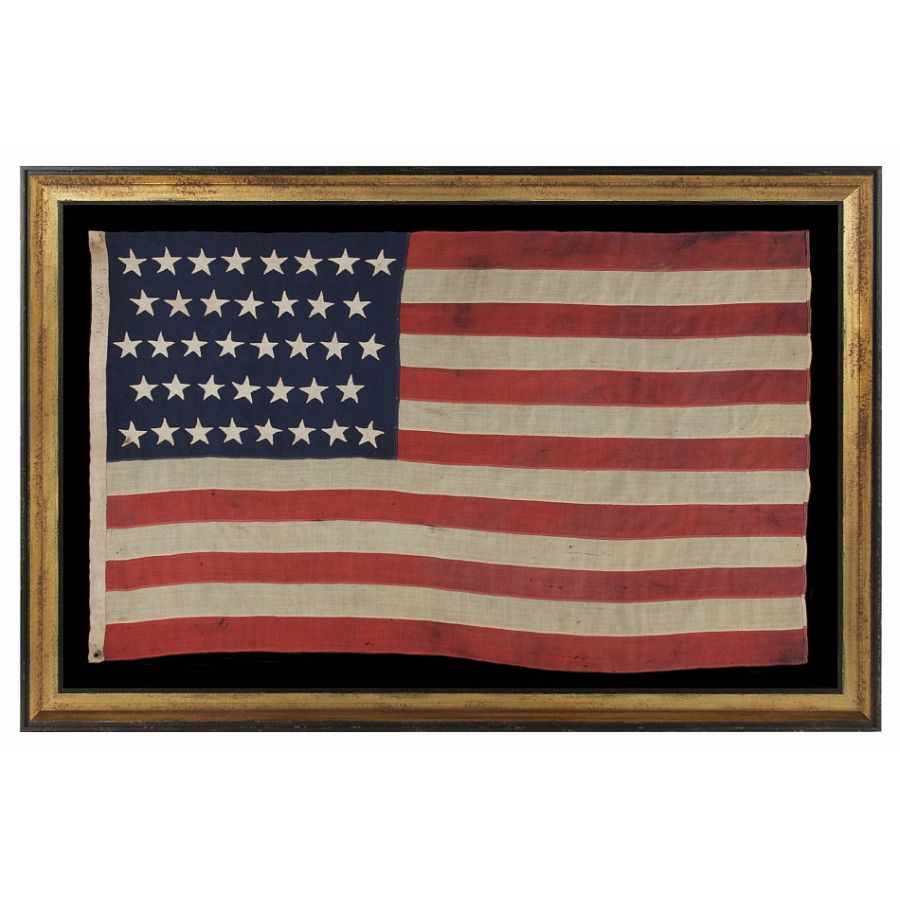
| |
38 HAND-SEWN STARS ON AN ANTIQUE FLAG IN A SMALL SCALE FOR THE 19TH CENTURY, SIGNED ALBANY, NEW YORK, 1876-1889, COLORADO STATEHOOD |
|
| Available: |
Sold |
| Frame Size (H x L): |
45.5" x 68.25" |
| Flag Size (H x L): |
34" x 57.25" |
|
| Description....: |
|
38 HAND-SEWN STARS ON AN ANTIQUE FLAG IN A SMALL SCALE FOR THE 19TH CENTURY, SIGNED ALBANY, NEW YORK, 1876-1889, COLORADO STATEHOOD:
38 star American national flag with hand-sewn stars and in an extremely small scale among flags with pieced-and-sewn construction that were made during the 19th century.
The stars are made of cotton, hand-sewn, and double-appliqued (applied to both sides). These are arranged in lineal rows in counts of 8-7-8-7-8. All of the stars are basically oriented in an upright position on their vertical axis (i.e., with one point up), although there is some irregularity. The stripes and canton of the flag are made of wool bunting that has been pieced with treadle stitching, which is typical of the period. There is an especially coarse linen binding along the hoist which originally had two brass grommets, one of which was torn from the flag. Along this the numeral "5" was stenciled to indicate size (5 feet) and the words "Albany, N.Y." were inscribed with a dip pen, evidently to indicate where it was used. The name "H.P. Smith" was inscribed on the reverse. This would be the name of a former owner and it was common to mark flags in this fashion during the 19th century to indicate ownership.
Wool bunting was the most common fabric employed in the manufacture of flags for long-term outdoor use, both on sea and on land. The specific use may have been by the city, itself, or perhaps for an event held there. The exact purpose is not known and difficult to determine. The size is too small for the top of any large structure.
During the 19th century, flags with pieced-and-sewn construction (as opposed to printed) were typically eight feet long or larger. This is because they were important in their function as signals, meaning that they needed to be seen and recognized from a great distance. Even flags made for decorative purpose were generally very large by today's standards. A small flag was six feet in length. Smaller flags were even more unusual. This particular example is just shy of five feet on the fly. Since the average 19th century sewn flag can be cumbersome to frame and display in an indoor setting, many collectors prefer printed parade flags and smaller sewn flags, like this one, the size of which provides a good balance between visual impact and versatility.
Colorado became the 38th state on August 1st, 1876. This was the year of our nation's 100-year anniversary of independence. Although 37 was the official star count for the American flag in 1876, flag-making was a competitive venture, and no one wanted to be making 37 star flags when others were making 38's. It is for this reason that 38 and 13 stars (to represent the original 13 colonies) are more often seen at the Centennial International Exposition, the six-month long World's Fair held in Philadelphia in honor of the event. Some makers of printed parade flags were instead producing 39 star flags, in hopeful anticipation of the addition of another Western Territory. The 38 star flag became official in 1877 and was generally used until the addition of the Dakotas in 1889.
Mounting: The flag was stitched to 100% silk organza on every seam and throughout the star field for support. It was then sewn to a background of 100% cotton twill, black in color, which was washed to remove excess dye. An acid-free agent was added to the wash to further set the dye and the fabric was heat-treated for the same purpose. Fabric of similar coloration was placed behind the flag during the mounting process, both for masking purposes and to strengthen the flag against the dark ground. The mount was then placed in a black-painted, hand-gilded and distressed Italian molding. The glazing is U.V. protective plexiglas.
Condition: There is extremely minor mothing; far less than what is typically seen among surviving wool flags of the period. There is some dark soiling in the red stripes. The grommet at the top of the hoist binding was torn away and the area surrounding it was mildly soiled. There is very minor foxing and staining throughout. many of my clients prefer early flags to show their age and history of use. |
|
|
|
| Collector Level: |
Intermediate-Level Collectors and Special Gifts |
|
| Flag Type: |
Sewn flag |
|
| Star Count: |
38 |
|
| Earliest Date of Origin: |
1876 |
|
| Latest Date of Origin: |
1889 |
|
| State/Affiliation: |
New York |
|
| War Association: |
1866-1890 Indian Wars |
|
| Price: |
SOLD |
|
| |
Views: 2570 |
|
|
|

